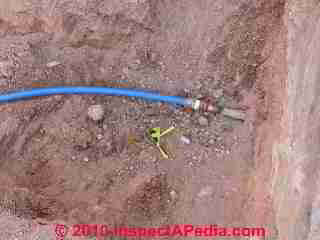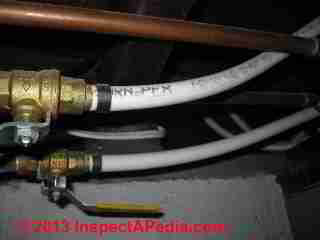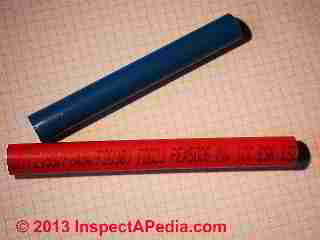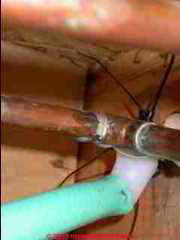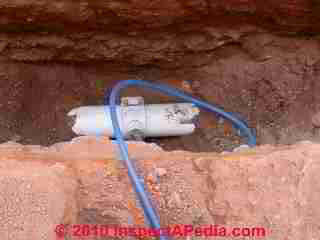 Copper vs Plastic Pipes in Buildings: Which is Better?
Copper vs Plastic Pipes in Buildings: Which is Better?
- POST a QUESTION or COMMENT about the advantages and disadvantages of copper versus plastic pipe for building water supply or drain piping
This article describes the pros and cons of using copper or plastic piping in buildings. We explain the advantages and possible downsides of choosing one or the other (plastic piping or copper piping for water supply or drains).
The question of which is better, copper or plastic piping, copper or PEX, copper or ABS, or copper and PVC or CPVC piping has answers but the results may not be as unambiguous as one imagines. Each piping material & piping connector or fitting system has both its advantages and its concerns.
InspectAPedia tolerates no conflicts of interest. We have no relationship with advertisers, products, or services discussed at this website.
- Daniel Friedman, Publisher/Editor/Author - See WHO ARE WE?
PLASTIC vs. COPPER PIPES in BUILDINGS: is one preferable?
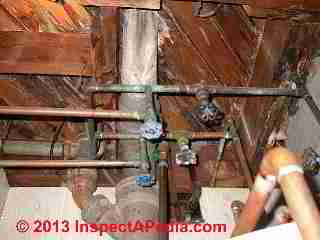 Many plumbers prefer to work with copper and, although plastic pipe is less expensive than copper, the fittings are expensive. Some areas do not allow plastic pipes based on environmental concerns.
Many plumbers prefer to work with copper and, although plastic pipe is less expensive than copper, the fittings are expensive. Some areas do not allow plastic pipes based on environmental concerns.
Some questions have been raised about the chemicals used in the adhesives used to join sections of piping, and the toxic gases given off from plastic piping during a fire.
Polyethylene (PE) and polyvinyl chloride (PVC) are only suitable for waste, underground water service pipes or cold water piping systems.
Our photographs of plastic water supply piping connections just below show a new water main (below left) and building supply pipe being connected to copper piping entering a building (below right) in San Miguel de Allende, Guanajuato, Mexico in 2010.
- Adapted with permission from The Home Reference Book
What About the Relative Safety of Copper Piping vs. PEX Piping in Buildings?
Details comparing the concerns, issues, codes, standards, features & questions about possible health concerns where PEX piping is used are found at PEX vs. COPPER PIPING SAFETY
Excerpts from that article are below.
Pex vs. Copper Water Supply Piping - which is better?
Reader Question: my daughter is doing extensive renovations on her house and the question has come up whether to use PEX or copper in the plumbing.
I did a google search and the informations is conflicted. Do you have knowledge of, and opinions about, this controversy? - Elisha Fisch, New York 2/17/2013
Reply:
 I have worked with both PEX and Copper piping, though of course
I have worked with both PEX and Copper piping, though of course
Copper has been around a long time. We recently chose PEX for both water suppy and for a hot water heating line in an addition and so far have been happy with the results.
Our PEX tubing photo at left shows its use in new construction completed in a New York structure in 2012.
You can see the ease of bending radius in these piping runs of both hot (red) and cold (blue) water supply lines.
What follows is an OPINION based on field experience as a builder, renovator & inspector:
PEX water supply piping offers some advantages over copper sweat-fitting piping installation
Our PEX tubing photo at left illustrates an older PEX piping product installed in a Haddonfield New Jersey Home.
- Fewer connections, faster installation, lower cost: A PEX piping installation typically requires fewer connections (as the tubing is so flexible). That may mean a reduced risk of a leak -since leaks often occur at connections in piping systems
- Leak resistance: the PEX tubing is generally inert, so it is rather immune to pinholing problems or corrosion problems experienced by copper piping in some systems where the water chemistry is aggressive or where there is an electrical ground snafu
- Noise transmission in PEX tubing is less than metal piping, though this is more an issue with drains that supply in most locations.
- Condensation on the cold water piping exterior is less than on metal cold water supply piping - a factor in some pipe routing locations where dripping condensate can wet an area or cause a mold aggravation.
See SWEATING (CONDENSATION) on PIPES, TANKS - Heat loss in hot water: Similarly, because of the observation that plastic transmits heat less quickly than copper I suspect that there is less heat loss when running hot water for washing or bathing as well as in heating system applications.
- Freeze damage risk reduction: In an area exposed to freeze risk I think that the risk of burst pipe damage is reduced (probably not eliminated) when plastic piping is ussed
- Compared with copper piping, a PEX water supply piping installation is easy and fast. Cuts are made with a simple hand tool, and fittings are installed with a different tool. Speed of installation should save on labor and maybe on overall cost; the connectors cost more but you use fewer of them;
PEX Supply Piping Caveats & Health Questions
- Possible MTBE Contamination associated with PEX water piping
- Chemax, a citation you provided (http://www.chemaxx.com/polytube1.htm ) cites a 2001 study into odor and taste complaints in new homes with PEX piping. An excerpt from that resource states:
- In the course the investigation it was discovered that t-butanol and MTBE were showing up in the water. The levels of t-butanol spanned a broad range, but in homes where the water had been stagnant for a period of time the concentrations were as high as 10,000 ppb and greater.
For comparison, the State of California has an enforceable Maximum Contaminant Level (MCL) on MTBE of 13 ppb, and a non-enforceable Action Level on t-butanol of 12 ppb. ...
Since the chemicals enter the water via a diffusion process, the concentrations were a function of how long the water was in contact with the tubing. ...
If you are considering whether to build your home with PEX, you might ask the PEX manufacturer for a written letter that clearly states whether chemicals will be added to the drinking water and if so, which chemicals and to what degree. Note that simply passing NSF Standards does not guarantee that chemicals will not be added to your drinking water. [18]
- In the course the investigation it was discovered that t-butanol and MTBE were showing up in the water. The levels of t-butanol spanned a broad range, but in homes where the water had been stagnant for a period of time the concentrations were as high as 10,000 ppb and greater.
- In 2013 study of these questions continues. Jia Tang et als reported:on modeling the properties of these plumbing materials where water is chlorinated. [21]
- U.S. EPA information on MTBE as an unregulated water contaminant is
at MTBE (methyl-t-butyl ether) in drinking water ( EPA website article at http://www.epa.gov/safewater/contaminants/unregulated/mtbe.html ) This article offers:
If you want to get your water tested [for MTBE], call the Safe Drinking Water Hotline (800-426-4791) or visit
EPA CERTIFIED LABS http://water.epa.gov/scitech/drinkingwater/labcert/statecertification.cfm to get the phone number for the office in your state that certifies drinking water laboratories.
More details are
at CHEMICAL CONTAMINANTS in WATER - SNAFUS: If the installer is not familiar with the product and uses wrong connectors or doesn't know how to install them expect trouble;
- Hot plastic water piping may require a few more points of support to avoid sags
- Connector confusion: Because there is a variety of types of connector systems for PEX it's important that the installer understand the system and that s/he has the right installing tools for the connectors chosen.
- Individual connector fittings cost more than the functionally equivalent copper sweat fittings such as elbows, unions, and adapters to threaded pipe for connection to some devices.
- If using plastic piping for heating system applications double check with the supplier that the piping selected is rated for safe use in the operating temperature range for the heating equipment.
- Piping system failures: I think that the issue cited was with connector problems with PEX was specific and not current
- Environmental issues about using plastic products have some standing with many people who are concerned about using petroleum products and about producing products that remain a very very long time in the environment if/when in waste form.
But copper mining does not fail to make its mark on the environment either, so one can make an argument against either material. Copper mining in at least some locations means excavating huge holes in the earth; wastewater from mining operations may poison nearby waterways, and some mining operations may also involve health risks or may exploit workers in other countries.
In my OPINION an argument about which material is more environmentally sound is plagued with ambiguity and conflicts, as are some cases of litigation.
Bottom line on PEX - 2014: although in more than one form PEX tubing or water piping has been used in Europe since the 1970's and in the U.S. for the last 20 years without [we have not found report of] a study confirming health injury associated with the material, still based on a literature review (citations are at the end of this article) in our OPINION there may be a contamination concern where PEX water supply piping is used.
We will continue to monitor the PEX health and contamination question and will update here.
CONTACT US by email to send field reports or to report on new studies.
Copper Water Supply Piping: features, propertis, comparison with plastic supply piping in buildings
We discuss types of copper piping and their intended uses and copper fittings beginning
at COPPER PIPING in BUILDINGS.
- Copper piping is something that I personally love aesthetically
- Copper supply piping is possibly familiar to more installers
- Copper pipe fittings & connectors are less confusing than plastic - standard, old, known to old-timers
- If all of the supply or drain piping in a building are continuous metal, then grounding the piping system increases electrical safety - a toaster dropped into a sink should blow a fuse or trip a breaker. This is a somewhat subtle safety point for which we have opinion, not data.
 Copper Supply & Drain Piping Caveats
Copper Supply & Drain Piping Caveats
- Copper piping too is at risk of leaks, even long-standing clandestine in-building-cavity leaks (when the leak is tiny) if each fitting is not installed properly
- Condensation where cold water supply pipes run through building spaces is common on all pipe materials but occurs more quickly on metal pipes such as the copper cold water supply piping in our photo at left.
In some locations the condensation and dripping of water can contribute to a building mold, insect, or other water-related building problem. - More than plastic water supply piping, copper piping is more vulnerable to leaks caused by aggressive water chemistry, or by an electrical ground mistake as well as leaks due to galvanic corrosion if piping is mixed with steel in an older home (unless you use proper diaelectric fittings at those joints).
Also see GALVANIC SCALE & METAL CORROSION - More easily than plastic water supply piping, copper pipes can be damaged by vibration (OPINION),
- An amateur installation during copper fitting sweating (soldering) sometimes pushes too much copper into the joint leading to a very hard-to-find flow restriction.
- Lead in solder used to join copper water supply piping in older buildings can present a lead poisoning health hazard that varies by the extent of lead solder used, how the joints were soldered (did the installer push blobs of solder into the pipe interior), and the chemistry of water flowing through the pipes. Lead hazards associated with water piping are discussed in detail
at LEAD PIPES in BUILDINGS.
Our photo (left) shows how a homeowner coped with a leak at a soldered (sweated) copper water supply pipe elbow that was difficult to reach for repair.
We discuss types of copper piping and their intended uses and copper fittings beginning
at COPPER PIPING in BUILDINGS.
In sum, I don't believe there is a single "right" answer, and each material has some advantages and features that may make it fit a particular installation best.
But when I ask Eric Galow, who is a full time builder, he's a PEX man all the way.
...
Continue reading at PLASTIC PIPE LEAK CAUSES or select a topic from the closely-related articles below, or see the complete ARTICLE INDEX.
Or see these
Recommended Articles
- PLASTIC PIPE LEAK CAUSES
- PLASTIC PIPING ABS CPVC PB PEX PPR PVC - home
- LEAK CAUSES in WATER PIPING for a discussion of the causes of leaks in copper or other metal water pipes
Suggested citation for this web page
PLASTIC vs. COPPER PIPES in BUILDINGS at InspectApedia.com - online encyclopedia of building & environmental inspection, testing, diagnosis, repair, & problem prevention advice.
Or see this
INDEX to RELATED ARTICLES: ARTICLE INDEX to PLUMBING SYSTEMS
Or use the SEARCH BOX found below to Ask a Question or Search InspectApedia
Ask a Question or Search InspectApedia
Try the search box just below, or if you prefer, post a question or comment in the Comments box below and we will respond promptly.
Search the InspectApedia website
Note: appearance of your Comment below may be delayed: if your comment contains an image, photograph, web link, or text that looks to the software as if it might be a web link, your posting will appear after it has been approved by a moderator. Apologies for the delay.
Only one image can be added per comment but you can post as many comments, and therefore images, as you like.
You will not receive a notification when a response to your question has been posted.
Please bookmark this page to make it easy for you to check back for our response.
IF above you see "Comment Form is loading comments..." then COMMENT BOX - countable.ca / bawkbox.com IS NOT WORKING.
In any case you are welcome to send an email directly to us at InspectApedia.com at editor@inspectApedia.com
We'll reply to you directly. Please help us help you by noting, in your email, the URL of the InspectApedia page where you wanted to comment.
Citations & References
In addition to any citations in the article above, a full list is available on request.
- [3] PB (polybutylene with mechanical fittings) Piping leaks: especially in mobile homes and in the U.S. South, for example trailers and double-wides throughout Florida that were piped with this material - per M Cramer. See "Polybutylene Piping: Time Bomb?" Daniel Friedman, Journal of Light Construction, August 1996 [Technical Q&A] .
- [4] ABS Plastic Pipe: "All Black -hit," defective black ABS plastic waste pipe manufactured in the mid 1980's failed by cracking. Additional information: www.abspipes.com
- [5] Polybutylene Plumbing (plastic pipes): gray plastic water supply piping cracked, leaked, and resulted in a class action and settlement.
- [6] ABS Plastic Drain/Waste/Vent (DWV) pipe failures: reported for Centaur, Phoenix, Polaris, Gable, and Spartan pipe mfgs. for pipe made between 1985 and 1988. CPSC Hot Line: 800-638-8270 or ABS Drain Leaks/Failures-Class Action Settlement COX settlement through Shell Oil set up by a contractor involved in the settlement Plumbing Failures: Spencer Class settlement. 10% of replacement cost/damages, only for acetal (plastic)fittings Polybutylene plumbing lawsuit proposed settlement-old site
- COX settlement through Shell Oil set up by a contractor involved in the settlement
- Additional information: ABS PLASTIC PIPE FAILURES
- Eric Galow, Galow Homes, Lagrangeville, NY. Mr. Galow can be reached by email: ericgalow@gmail.com or by telephone: 914-474-6613. Mr. Galow specializes in residential construction including both new homes and repairs, renovations, and additions.
- [7] PB Technology Center (information about PB Pipes) Tel: 800-338-7732, also see the 1990 PB Pipe recommendations published by the Polybutylene Product Line Committee of the Plastic Pipe and Fittings Association.
- Polybutylene Plumbing Failures: Spencer Class settlement, Web: spencerclass.com, 10% of replacement cost/damages, only for acetal (plastic)fittings
- [8] Polybutylene plumbing info at U. Arizona
- [9] Polybutylene piping lawsuit settlement website
- [10] Polybutylene plumbing lawsuit proposed settlement-old site
- [12] Zurn Manufacturing, Web: zurn.com , Zurn Pex, Inc., Highway 11 East, Commerce, TX 75428, Tel: (903) 886-2580
provides information about installing and using PEX piping including Type b PEX through their website. Quoting from the company's website
Zurn was founded in 1900 in Erie, PA. It originally manufactured a patented backwater valve, and it now manufactures and distributes one of the largest plumbing products packages in the world! Zurn includes: the Specification Drainage Operation, AquaFlush flush valves, AquaSense sensor-operated plumbing products, AquaSpec commercial faucets, Wilkins, Zurn Light Commercial, Flo-Thru, the Chemical Drainage Systems, Zurn PEX Plumbing Systems and Zurn Radiant Heat. - [13] Zurn PEX PLUMBING DESIGN AND APPLICATION GUIDE [PDF] - web search 2023/04/06 & 12/23/2010, original source zurn.com/operations/pexrh/pdfs/installation/PEXDesApplGuide.pdf
- [14] Zurn Pex Plumbing Products Liability Litigation, United States Court of Appeals
FOR THE EIGHTH CIRCUIT, No. 10-2267, Filed 6 July 2011, Quoting:
Minnesota homeowners brought this action1 against Zurn Pex, Inc. and Zurn Industries, Inc (Zurn) alleging that brass fittings used in the company's cross linked polyethylene (PEX) plumbing systems are inherently defective. In pretrial motions the homeowners sought class certification for their consumer protection, warranty, and negligence claims, and Zurn moved to strike the testimony of two of the homeowners’ experts. After denying Zurn's motion to strike the expert testimony, the district court2 granted the homeowner requests for class certification for their warranty and negligence claims, but denied it for their consumer protection claims. Zurn appeals from the district court's certification order. We affirm.
Web search 4/12/12, original source: www.ca8.uscourts.gov/opndir/11/07/102267P.pdf - [15] Uponor, Inc., F1807 Plumbing Court File No. - United States District Court, District of Minnesota, In Re: Uponor, Inc., F1807 Plumbing Court File No. 11-MD-2247 ADM/JJK
Fittings Products Liability Litigation, "
Order Granting Motion to Certify Class for Settlement Purposes and for Preliminary Approval of Class Action Settlement and Form and Dissemination of Notice to the Class" Quoting:
The Motion for Preliminary Approval of Class Action Settlement was heard on January 12, 2012. After review of pleadings and briefing, and having heard the arguments of counsel for good cause shown, it is hereby ORDERED that: (1) the Motion for Preliminary Approval of Nationwide Class Action Settlement Agreement; (2) preliminary and conditional certification of a settlement class; (3) approval of the form and content of Notice and Settlement; (4) an injunction and stay of all claims and actions against the RTI Defendants
Web search 4/12/12, original source: http://www.mnd.uscourts.gov/MDL-Uponor/ - [16] Bonnie Ransom Stern & Gustavo Lagos, "Are There Health Risks from the Migration of Chemical Substances from Plastic Pipes into Drinking Water? A Review", Human and Ecological Risk Assessment: An International Journal
Volume 14, Issue 4, 2008, Abstract:
Plastic pipes used to convey hot and cold drinking water are synthetic polymers containing numerous additives that enhance durability, impact strength, and toughness, and resist material degradation. Although some research studies have been conducted to evaluate the type and levels of chemical substances migrating from polymeric materials into drinking water, the potential adverse health effects associated with these compounds in potable water have not been described. This review evaluates the literature on the occurrence of regulated and unregulated substances in drinking water related to the use of plastic pipes, characterizes potential health hazards, and describes uncertainties associated with human health and exposure in need of further research. Of particular public health concern is the potential for sensitive populations to be exposed to short-term elevations in leachates during critical periods, and for co-occurring leachates targeting the same organ(s) and/or sharing a common mode of toxic action to have additive or synergistic effects. Contaminants are measured in the distribution system, not at the tap where human exposure actually occurs. For increased health protection, it is important to identify compounds that migrate from plastic pipes into drinking water and to better quantify human exposures and health hazards to these substances and their degradates. - [17] Andrew J. Whelton, Andrea M. Dietrich, Daniel L. Gallagher, "Chapter 6 Impact of Chlorinated Water Exposure on Chemical Diffusivity and Solubility,
Surface and Bulk Properties of HDPE and PEX Potable Water Pipe", in Advancing Potable Water Infrastructure through an Improved Understanding of Polymer
Pipe Oxidation, Polymer–Contaminant Interactions, and Consumer Perception of Taste, Andrew James Whelton
Dissertation submitted to the Faculty of the
Virginia Polytechnic Institute and State University
In partial fulfillment of the requirements for the degree of
DOCTOR OF PHILOSOPHY
In
Civil Engineering
Andrea M. Dietrich, Chair
Daniel L. Gallagher
Marc A. Edwards
Brian J. Love
James M. Tanko, April 2, 2009
Blacksburg, Virginia. Abstract: While more than 100 years of research has focused on removing acute and chronic health
threats from water, substantially less study has focused on potable water infrastructure and water
quality deterioration, monitoring technologies, and relationships between water taste and
consumer health. These knowledge–gaps have left infrastructure users, owners, regulators, and
public health professionals largely unaware of how premise and buried polymer water pipes
deteriorate and sorb/ desorb organic contaminants during normal operations and following water
contamination events. These knowledge–gaps also prevent infrastructure managers from
producing drinking water that optimizes mineral content for both water taste and health benefits,
and employing a monitoring tool capable of immediately detecting water contamination or
equipment failures.
Research was conducted to address these challenges using analytical chemistry,
environmental engineering, food science, polymer chemistry, public health, and material science
principles. This work was enhanced by collaborations with sixteen American water utilities and
the National Institute for Standards and Technology. These efforts were funded by the National
Science Foundation, American Water Works Association, and the Water Research Foundation.
Research results are unique and provide important scientific contributions to the public
health, potable water, and material science industries. Particular achievements include the: (1)
Evaluation of linkages between minerals, water palatability, and health useful for water
production and public health decisions; (2) Creation of a novel infrastructure and water quality
surveillance tool that has begun water utility implementation in the USA; (3) Development of an
accelerated chlorinated water aging method with stable water pH, free chlorine, and alkalinity
concentration that enables interpretation of polymer pipe surface and bulk characteristic changes;
(4) Discovery that polar compounds are 2–193% more soluble in PEX than HDPE water pipes;
(5) Finding that several polymer and contaminant properties can be used to predict contaminant diffusivity and solubility during sorption and desorption in new, lab aged, and water utility PE
pipes; and the (6) Discovery that chlorinated water exposure of HDPE and PEX pipes increases
polar contaminant diffusivity during sorption by 50–162% and decreases diffusivity during
desorption as much as 211%. Outcomes of this work have domestic and global significance, and
if engaged, can greatly improve public health protection, potable water infrastructure operations,
water quality, sustainability, and regulation. - [18] Chemax, "Cross-Linked Polyethylene Tubing and Water Contamination", retrieved 2/17/2013, original source: http://www.chemaxx.com/polytube1.htm [copy on file as [Water Contamination chemical investigation.pdf]
- [19] Ingun Skjevrak, Anne Due, Karl Olav Gjerstad, Hallgeir Herikstad "Volatile organic components migrating from plastic pipes (HDPE, PEX and PVC) into drinking water", Water Research Volume 37, Issue 8, April 2003, Pages 1912–1920
Abstract: High-density polyethylene pipes (HDPE), crossbonded polyethylene pipes (PEX) and polyvinyl chloride (PVC) pipes for drinking water were tested with respect to migration of volatile organic components (VOC) to water. The odour of water in contact with plastic pipes was assessed according to the quantitative threshold odour number (TON) concept. A major migrating component from HDPE pipes was 2,4-di-tert-butyl-phenol (2,4-DTBP) which is a known degradation product from antioxidants such as Irgafos 168®. In addition, a range of esters, aldehydes, ketones, aromatic hydrocarbons and terpenoids were identified as migration products from HDPE pipes. Water in contact with HDPE pipes was assessed with respect to TON, and values ⩾4 were determined for five out of seven brands of HDPE pipes. The total amount of VOC released to water during three successive test periods were fairly constant for the HDPE pipes. Corresponding migration tests carried out for PEX pipes showed that VOC migrated in significant amounts into the test water, and TON ⩾5 of the test water were observed in all tests. Several of the migrated VOC were not identified. Oxygenates predominated the identified VOC in the test water from PEX pipes. Migration tests of PVC pipes revealed few volatile migrants in the test samples and no significant odour of the test water. - [20] Andrew J. Whelton, Ph.D., M.ASCE; Andrea M. Dietrich, Ph.D., Aff.ASCE; and Daniel L. Gallagher, Ph.D., P.E., M.ASCE, ”Contaminant Diffusion, Solubility, and Material Property Differences between HDPE and PEX Potable Water Pipes.” J. Environ. Eng., 136(2), 227–237.
doi: 10.1061/(ASCE)EE.1943-7870.0000147
Abstract: the objectives of this work were to identify differences between the composition, bulk properties, contaminant diffusivity and solubility for new high-density polyethylene (HDPE) pipe and crosslinked polyethylene (PEX) pipe, as well as determine which contaminant and polymer properties are useful for predicting contaminant fate in water pipe. Variations in PE pipe density (0.9371–0.9547 g/cm3) , crystallinity (69–72%), crosslinking (60 and 76%), and oxidative induction time (33 to >295 min .) were detected. While numerically these differences seem minor, results show that slight material differences have a notable effect on contaminant diffusivity and solubility. Nonpolar contaminant diffusivity and solubility were best predicted by bulk density. Polar contaminants were more soluble and diffused faster through PEX than HDPE pipes because PEX pipes contained a greater amount of oxygen. For all materials, dipole moment and Log Kow were good predictors of contaminant fate and molecular volume was only useful for predicting diffusivity and solubility values for haloalkane and nonpolar aromatic contaminants. - [21] Jia Tang, Daniel L. Gallagher, and Andrea M. Dietrich. (2013) Predicting Permeation of Organic Contaminants into Polyethylenes. Journal of Environmental Engineering 139:2, 205-212
Online publication date: 1-Feb-2013.
Abstract:
A model was developed and validated for predicting solubility and diffusion coefficients for contaminants permeating polyethylene (PE) materials used for water pipes and geomembranes. Model development was based on diffusivity and solubility of 13 contaminants and six PE materials that were new and/or aged in chlorinated water. Physical and chemical properties of the contaminants and PEs were included as variables in the model. Tree regression was used to select variables, and multiple linear regression was used to develop predictive equations for contaminant diffusivity and solubility in PE. Organic contaminant properties, especially dipole moment and octanol-water partition coefficient, had greater predictive capability than PE properties. Coefficients of determination (R2)>0.8 were obtained for the multiple linear regressions. Model coefficients changed slightly between new PE materials and chlorine-aged PE, but these changes were not statistically significant. Good agreement was demonstrated between model predictions and measured data from an independent data set. These results provide guidance for material selection for both water pipes and geomembranes and assessing contamination potential. - [22] Andrew J. Whelton, Andrea M. Dietrich, and Daniel L. Gallagher. (2011) Impact of Chlorinated Water Exposure on Contaminant Transport and Surface and Bulk Properties of High-Density Polyethylene and Cross-Linked Polyethylene Potable Water Pipes. Journal of Environmental Engineering 137:7, 559-568
Online publication date: 1-Jul-2011. Abstract:
The aim of this work was to determine if the aging of polyethylene (HDPE, PEX-A and PEX-B) water pipes by exposure to chlorinated water altered polar and nonpolar contaminant diffusivity and solubility by analyzing new, laboratory-aged, and exhumed water-distribution system polyethylene (PE) pipes. After 141 days of aging in pH 6.5 water with 45 mg/L free chlorine, the surface chemistry and bulk properties of PEX-A pipe were unaffected. Carbonyl bonds (σ=1,713 cm−1) were detected on the surfaces of HDPE and PEX-B pipe, and these oxygenated surfaces became more hydrophilic, resulting in statistically significant increases in diffusion rates. All 10 contaminant and four pipe material combinations had diffusivity increases on average of 50% for polar contaminants and 5% for nonpolar contaminants. Contaminant solubility was slightly increased for aged PEX-A and slightly decreased for PEX-B pipes. Toluene and trichloromethane diffusivity and solubility values for 7- to 25-year-old buried water utility pipes were similar to values for new and laboratory-aged HDPE-based materials. Because chlorinated water exposure alters how polar contaminants interact with aged PE pipes, results of this work should be considered in future health risk assessments, water quality modeling, pipe performance, and service-life considerations. - [23] ANDREW J. WHELTON & TINH NGUYEN, "Contaminant Migration from Polymeric Pipes used in Buried Potable Water Distribution Systems: A Review", Critical Reviews in Environmental Science and Technology, February 2012 posted online,
Abstract: Polymeric pipes are increasingly being installed in water distribution systems because of their many advantages. Contaminant migration from polymer pipes into drinking water is a growing concern in the United States and environmental engineers are evaluating the role of these materials on water quality, system operation, and regulatory compliance. To aid these efforts and serve as a source of background information, this paper critically reviews available literature on polymeric potable water pipes in use, known contaminants released from in–service and new piping, their perceived sources, and outlines future challenges in the U.S. and abroad. - [24] Andrew James Whelton, "Advancing Potable Water Infrastructure through an Improved Understanding of Polymer Pipe Oxidation, Polymer–Contaminant Interactions, and Consumer Perception of Taste", Dissertation submitted to the Faculty of the Virginia Polytechnic Institute and State University In partial fulfillment of the requirements for the degree of DOCTOR OF PHILOSOPHY In Civil Engineering, April 2, 2009 Blacksburg, Virginia, retrieved 2/17/2013, original source http://scholar.lib.vt.edu/theses/ available/etd-04162009-113815/unrestricted/ FINALWheltonDissertationMay09.pdf#page=158
- [25] Website: GreenBuildingAdvisor.com, "PEX vs Copper", retrieved 2/18/2013, original source: http://www.greenbuildingadvisor.com/ community/forum/green-products-and-materials/ 16256/pex-vs-copper [copy on file as PEX vs Copper _ GreenBuildingAdvisor.pdf]
- [26] Website: GreenBuildingAdvisor.com," How Safe is PEX tubing?", retrieved 2/18/2013, original source: http://www.greenbuildingadvisor.com/ blogs/dept/qa-spotlight /how-safe-pex-tubing [copy on file as How Safe is PEX tubing_GreenBuildingAdvisor.pdf]
- [27] Lauren Hunter, "California’s PEX Battle Continues", Remodeling Magazine, June 2010, Website: Builderonline.com, "x", retrieved 2/18/2013, original souirce: http://www.builderonline.com/legislation/californias-pex-battle-continues.aspx [copy on file as California’s PEX Battle Continues - Plumbing, Legal Issues, Legislation - Builder Magazine.pd]
- [28] Contractor Magazine, "California approves PEX for plumbing — again- Contractor Magazine.pdf", retrieved 2/18/2013, original source: http://contractormag.com/news/ california-pex-plumbing-1234 [copy on file as California approves PEX for plumbing — again- Contractor Magazine.pdf]
- [29] "Sources of Lead [in and around the home]", New York State Health Department, website retrieved 2/19/2013, original source: http://www.health.ny.gov/environmental/lead/sources.htm [copy on file as Lead_Sources_NYS_DOH.pdf]
- [30] Wikipedia Web: https://www.wikipedia.org/ provided background information about some topics discussed at this website provided this citation is also found in the same article along with a " retrieved on" date. NOTE: because Wikipedia entries are fluid and can be amended in real time, we cite the retrieval date of Wikipedia citations and we do not assert that the information found there is necessarily authoritative. Kitec web search retrieved 02/19/2013, original source: http://en.wikipedia.org/wiki/Kitec
- Eric Galow, Galow Homes, Lagrangeville, NY. Mr. Galow can be reached by email: ericgalow@gmail.com or by telephone: 914-474-6613. Mr. Galow specializes in residential construction including both new homes and repairs, renovations, and additions.
- Mark Cramer Inspection Services Mark Cramer, Tampa Florida, Mr. Cramer is a past president of ASHI, the American Society of Home Inspectors and is a Florida home inspector and home inspection educator. Mr. Cramer serves on the ASHI Home Inspection Standards. Contact Mark Cramer at: 727-595-4211 mark@BestTampaInspector.com
- John Cranor [Website: /www.house-whisperer.com ] is an ASHI member and a home inspector (The House Whisperer) is located in Glen Allen, VA 23060. He is also a contributor to InspectApedia.com in several technical areas such as plumbing and appliances (dryer vents). Contact Mr. Cranor at 804-873-8534 or by Email: johncranor@verizon.net
- In addition to citations & references found in this article, see the research citations given at the end of the related articles found at our suggested
CONTINUE READING or RECOMMENDED ARTICLES.
- Carson, Dunlop & Associates Ltd., 120 Carlton Street Suite 407, Toronto ON M5A 4K2. Tel: (416) 964-9415 1-800-268-7070 Email: info@carsondunlop.com. Alan Carson is a past president of ASHI, the American Society of Home Inspectors.
Thanks to Alan Carson and Bob Dunlop, for permission for InspectAPedia to use text excerpts from The HOME REFERENCE BOOK - the Encyclopedia of Homes and to use illustrations from The ILLUSTRATED HOME .
Carson Dunlop Associates provides extensive home inspection education and report writing material. In gratitude we provide links to tsome Carson Dunlop Associates products and services.


